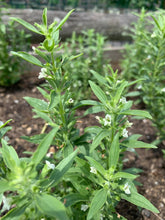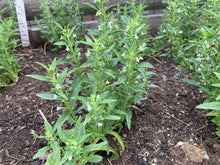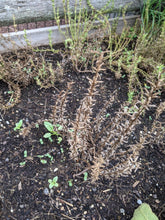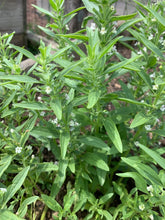'Voronezh' Dragon's Head
Regular price
$4.00
Sale
Lallemantia iberica
Origin: Unknown (via Voronezh, former USSR)
Improvement status: Landrace
Seeds per packet: ~30
Germination tested 10/2024: 84%
Life cycle: Annual
This species — named for its flowers that look like open-mouthed dragon heads — has been cultivated since prehistoric times. The leaves and young growing tips are eaten in salads or as a cooked vegetable, and the seeds produce an edible oil (known generally as Lallemantia oil). Oil content of the seeds can be as high as 38%. Bronze Age archaeological sites in northern Greece have been found to contain stores of Lallemantia seeds, and archaeologists believe they were used mainly for oil for food, lighting, and medicine. It is also useful as a drying oil (like linseed oil) for wood varnish or leather conditioning, as well as in paint, ink, soap, and linoleum. The seeds produce a mucilage that can be used for making a clear, edible film for coating fruits, vegetables, and other food products.
Lallemantia iberica seeds are used medicinally, as a stimulant and diuretic. A recent scientific study found that seed extracts exhibited significant anti-bacterial action. In Iran, a closely related species (Lallemantia royleana) is used as a folk treatment for fever and coughs. Seeds are also edible, and apparently good sources of fiber, oil, protein, and polysaccharides. This species is known as "balangu shahri" in Iran.
We don't know anything about the origin of this variety, other than that it came to the USDA from the All-Union Propagation Institute in the then-Soviet Russian city of Voronezh. The species is believed to originate in the Caucusus and Middle East, but it long ago spread far from that region, so this one really could've come from anywhere. We've given it the name 'Voronezh', because that's as far back as we can trace it. Like others of the species, it has pretty white flowers on somewhat floppy plants. The smooth green leaves have a mild minty flavor and make a pleasant tea.
We got our seed stock from the USDA, and this year's seeds were grown out by our friend Klielle Glanzburg-Krainin, a Philadelphia-based colleague from the Cooperative Gardens Commission.
GROWING TIPS: Easy to grow. Surface sow or bury seeds a half-inch deep. Self-seeds readily.








